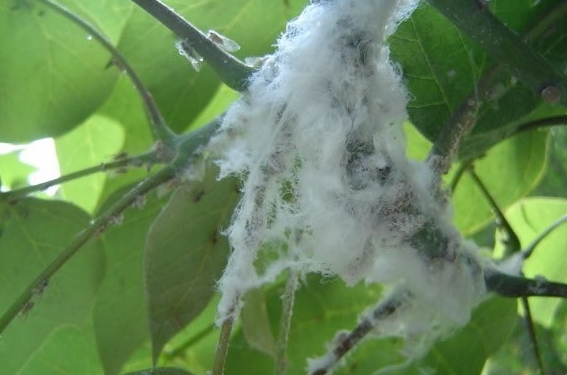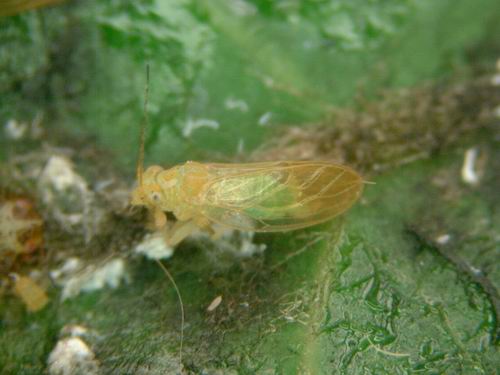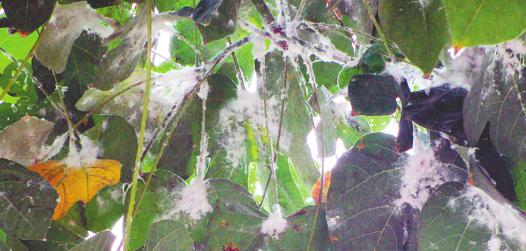The harm of paulownia planthopper control methods of paulownia planthopper
Paulownia planthopper, also known as sycamore planthopper, belongs to the family Homoptera, which is distributed in North China, East China, Central China and Northwest China, and is the most easily infected pest, so it is very necessary to master some methods to control it.

1. Morphological characteristics of paulownia planthopper
Adults: body length 4 mm to 5 mm, wingspan 12 mm to 13 mm, yellowish green body, obvious depression at the end of the head, hemispherical protruding compound eyes, 3 single eyes arranged in the shape of inverted "goods". The antennae are yellow with 10 knots, the last two are black, and there are two manes at the end. The anterior chest dorsal plate is arched, and the anterior and posterior edges are dark brown. The middle chest dorsal plate has two longitudinal brown lines, the front shield plate has a banded groove, and the shield plate has 6 longitudinal lines. The feet are yellowish, the claws are black, and there are a pair of conical protuberances on the hindfoot. The wings are transparent and the veins are light brown. The abdominal dorsal plate is light yellow and there is a brown transverse band at the front of each segment. The length of the male adult is from 4 mm to 4.5 mm. 7 segments can be seen in the abdominal dorsal plate and 6 segments in the web. The abdomen and abdominal dorsal plate of the female are one more than those of the male.
Eggs: long ovoid, slightly pointed at one end, 0.7 mm long, light yellow or yellowish brown at birth, reddish yellow near hatching, and red eye spots can be seen.
Nymph: a total of five years old, the first to the second instar nymph body is flat, slightly rectangular, yellow or green, the last instar nymph body is nearly cylindrical, tea yellow is often green, the abdomen has developed wax glands, so the body is covered with white flocs. The antennae have 10 nodes, the wing buds are well developed, veins can be seen, and there are a pair of black spots between the wing buds.

Second, the occurrence symptoms of paulownia planthopper
The green paulownia planthopper has three generations a year in the central and southern part of North China, overwintering with eggs on the branches, and the overwintering eggs hatch one after another from late April to early May in the following year. The nymph of the first generation is harmful, and the nymph duration is about 30 days. The second generation nymph began to appear in late June, the active period was in the middle of July, the third generation nymph was harmful in the first and middle of September, and the adults gradually laid eggs in late October to survive the winter. The development of the insect is very irregular and the generations overlap seriously.
Paulownia planthopper is an important pest of paulownia, which is damaged by adults and nymphs, and nymphs can secrete a large amount of wax, which affects the photosynthesis and respiration of trees; from May to June, wax falls one after another, which seriously pollutes the surrounding environment; nymphs secrete wax, honeydew leads to the occurrence of coal fouling, so that Qingtong suffers double damage. In severe cases, the leaves fall early, the branches are dry, the epidermis is rough, and the wind is easy to break, which seriously affects the growth and development of trees.

3. Control methods of paulownia planthopper
1. Chemical control, in the middle and last ten days of May, 10% aphid lice powder 2000 Mel 2500 times, 2.5% imidacloprid 1000 times, or 1.8% avermectin 2500Mel 3000 times could be sprayed.
two。 Pay attention to the protection and utilization of parasitoids, ladybugs, lacewings and other natural enemies.
3. Root application has a good effect on the control of paulownia planthopper. This method overcomes the shortcomings of spraying method, no equipment, easy to operate and safe to use. It is best to choose insecticides with internal absorption, such as imidacloprid, omethoate, acephate and so on. In addition, some non-inhaled pesticides can also be used in rhizosphere application, such as cypermethrin. When using Qingtong in urban landscaping, we should pay attention to the selection of low-toxic pesticides.

In addition to the paulownia planthopper, the cotton leaf borer is also harmful to the tree. Chemical control and natural enemy protection can also be used to control it.
Related
- Wuhan Hospital Iron Tree Blooming Result Was Instantly Frightened by the Gardener Master
- Which variety of camellia is the most fragrant and best? Which one do you like best?
- What is the small blue coat, the breeding methods and matters needing attention of the succulent plant
- Dormancy time and maintenance management of succulent plants during dormancy
- Minas succulent how to raise, Minas succulent plant pictures
- What are the varieties of winter succulent plants
- How to raise succulent plants in twelve rolls? let's take a look at some experience of breeding twelve rolls.
- Attention should be paid to water control for succulent plants during dormant period (winter and summer)
- Watering experience of twelve rolls of succulent plants
- Techniques for fertilizing succulent plants. An article will let you know how to fertilize succulent plants.



